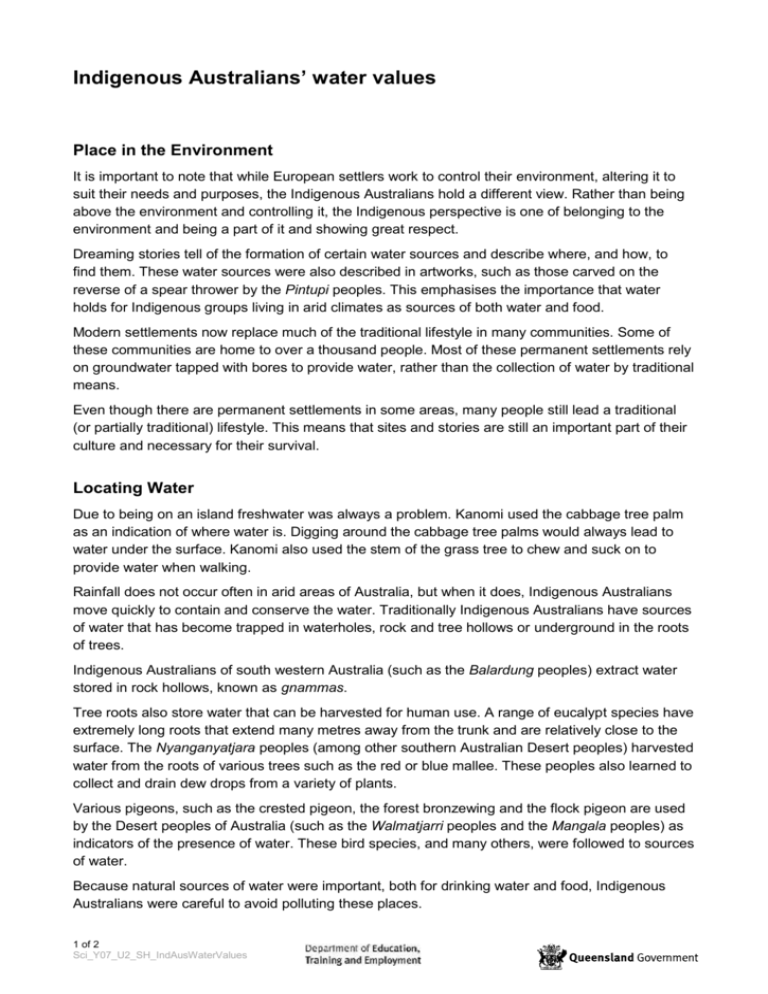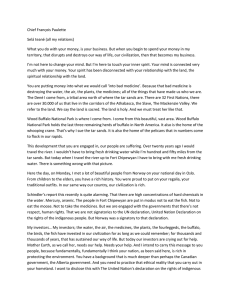Kanomi water
advertisement

Indigenous Australians’ water values Place in the Environment It is important to note that while European settlers work to control their environment, altering it to suit their needs and purposes, the Indigenous Australians hold a different view. Rather than being above the environment and controlling it, the Indigenous perspective is one of belonging to the environment and being a part of it and showing great respect. Dreaming stories tell of the formation of certain water sources and describe where, and how, to find them. These water sources were also described in artworks, such as those carved on the reverse of a spear thrower by the Pintupi peoples. This emphasises the importance that water holds for Indigenous groups living in arid climates as sources of both water and food. Modern settlements now replace much of the traditional lifestyle in many communities. Some of these communities are home to over a thousand people. Most of these permanent settlements rely on groundwater tapped with bores to provide water, rather than the collection of water by traditional means. Even though there are permanent settlements in some areas, many people still lead a traditional (or partially traditional) lifestyle. This means that sites and stories are still an important part of their culture and necessary for their survival. Locating Water Due to being on an island freshwater was always a problem. Kanomi used the cabbage tree palm as an indication of where water is. Digging around the cabbage tree palms would always lead to water under the surface. Kanomi also used the stem of the grass tree to chew and suck on to provide water when walking. Rainfall does not occur often in arid areas of Australia, but when it does, Indigenous Australians move quickly to contain and conserve the water. Traditionally Indigenous Australians have sources of water that has become trapped in waterholes, rock and tree hollows or underground in the roots of trees. Indigenous Australians of south western Australia (such as the Balardung peoples) extract water stored in rock hollows, known as gnammas. Tree roots also store water that can be harvested for human use. A range of eucalypt species have extremely long roots that extend many metres away from the trunk and are relatively close to the surface. The Nyanganyatjara peoples (among other southern Australian Desert peoples) harvested water from the roots of various trees such as the red or blue mallee. These peoples also learned to collect and drain dew drops from a variety of plants. Various pigeons, such as the crested pigeon, the forest bronzewing and the flock pigeon are used by the Desert peoples of Australia (such as the Walmatjarri peoples and the Mangala peoples) as indicators of the presence of water. These bird species, and many others, were followed to sources of water. Because natural sources of water were important, both for drinking water and food, Indigenous Australians were careful to avoid polluting these places. 1 of 2 Sci_Y07_U2_SH_IndAusWaterValues It has been recorded that Arrernte peoples of Central Australia could even squeeze out water from the water-holding frog. This is a frog species that holds large amounts of water stored in its body. They are able to be found below the surface of claypans. In some inland areas, soaks were commonly used by the Luritja peoples. A soak is a place where water seeps through sand and collects where it comes up against rock or hard clay. Indigenous Australians (such as the Pintupi peoples and Arrernte peoples) knew of these places and were able to dig down and get water from them. Water Use At some rock holes, those which contain clean water, it is custom of the Arrernte peoples of Central Australia to often require that people sip the water without using their hands. This is done for hygienic purposes, so that the water is not contaminated for the next user. Sometimes a large rock was used to cover the hole to stop water escaping through evaporation or to prevent animals getting at it. Water Storage Water was often carried to areas where it was needed. Kanomi would use bailer shells to carry water. The shell was large enough to carry a few litres. The Kalkadoon peoples made bags, known as norlo, from the skins of large animals that could store and carry large amounts of water. European Reliance Early Europeans often depended on the knowledge of Indigenous Australians to help them find water in the Australian environment. Explorers in more modern times have also been aided by the knowledge that Indigenous Australians have passed down through stories and songs. These stories speak of how and where to find water in the arid environments of Australia. References Aboriginal People and Groundwater, 2007, Northern Territory Government, Darwin, viewed 20 September 2011, http://www.nt.gov.au/nreta/water/ground/people/aboriginal.html. Spencer, B & Gillen, F J, 1912, Across Australia, volume 1, MacMillan and Co., London. Bayly, I A E 1999, ‘Review of how indigenous people managed for water in desert regions of Australia’, Journal of the Royal Society of Western Australia, no. 82, p. 17-25. Roth, W E 1984, The Queensland Aborigines, volume 2, Hesperian Press, Victoria Park. Start a New Life in Australia 2009, Start-a-New-Life-in-Australia, viewed 20 September 2011, http://www.start-a-new-life-in-australia.com/aboriginal-food.html#axzz1WeaKGJwS. 2 of 2 Sci_Y07_U2_SH_IndAusWaterValues









